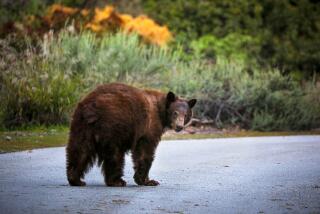Beavers Out of Place: An Ecological Blunder
BIG BEAR, Calif. â An experiment to save beavers, which were deliberately introduced into many parts of the San Bernardino National Forest and elsewhere in California, appears in some ways to have been entirely too successful, and that has wildlife biologists in a quandary. At least a decade ago a golden beaver stumbled into a pleasant grove of trees at the edge of the San Gorgonio Wilderness about 25 miles south of here and found a stand of aspens--its favorite food.
Today, after at least 10 years of what wildlife management experts discreetly refer to as âresource conflict,â one of the four aspen clusters in the grove has been devastated by beavers. And botanists say that the three remaining aspen clusters will probably meet the same fate if the beaversâ reproductive cycle is uninterrupted by natural forces such as flooding or predation by mountain lions and coyotes, or left undisturbed by the wildernessâs human stewards.
If the aspens are to be saved, according to Scott White, the U.S. Forest Service botanist for the wilderness, the beaver will have to be removed--possibly by trapping and killing.
The aspen grove is not a unique example of human-induced resource conflict involving beavers, experts agree. But, according to Gordon Gould, of the California Department of Fish and Game, the San Gorgonio incident is a telling example of how humans can fail miserably in their zeal to do the right thing.
Back in the 19th Century, the trapping of beavers to satisfy the demands of a booming fur trade resulted in near-extinction of the animal in North America by the turn of the century. As a result, beaver harvesting was outlawed and, by the 1920s, the animal had staged a miraculous comeback.
By the mid-1920s, said Gould, beavers were so plentiful that hunting was again allowed. But within a decade or so, he said, the species had been all but wiped out again, so permanent protections were put in place.
In California, fish and game officials decided in the mid-1940s to take out some insurance for the beaver by introducing it not just back into the range the animal had historically inhabited but also into areas where there is no record of the animal.
Elimination of some natural predators and other aspects of the encroachment of civilization have limited natural means to control beaver populations. Today, said White and other experts, heavy rains, flooding and natural disease epidemics are the only remaining natural means of control. Beaver protection programs in places as diverse as Massachusetts and Nevada have had similar results.
As animals with no logical evolutionary business in the area, the beavers introduced here, in the Sierra above the Owens Valley and in the Central Valley qualified as what biologists call âexotic species,â according to Robert Naiman, of the Center for Streamside Studies at the University of Washington in Seattle.
The problem, said Naiman and Susan Sferra, a U.S. Forest Service wildlife biologist, is that exotics introduced into a wild area are thrust as brash strangers into a complex of ecosystems that exist in delicate harmony.
âWhen you put animals like this in new habitat--certainly in areas where they truly never existed before--it is not a good idea,â Naiman said. âWhat happens is you get reverberations throughout all aspects of the ecosystem.â
In its appropriate ecologic place, said Naiman, the beaver is âabsolutely essentialâ to its habitat. So significant in its natural environmental niche is the beaver, said Naiman, that it qualifies as a âkeystone speciesâ in native areas.
But when the beaver is essentially dumped into a place it doesnât belong, Naiman, Gould and Sferra agreed, its environmental value sometimes becomes a hazard.
The problem is not just confined to the San Gorgonio Wilderness. For instance, said Phil Pister, a Department of Fish and Game biologist in Bishop, in the Owens Valley, beavers are in constant conflict with aqueducts and streams that move water to Southern California. Elsewhere, beavers have been known to jam intake pipes of hydroelectric stations.
California currently permits landowners whose holdings are seriously damaged by beavers to trap and kill the animals.
âWe need to learn how to live much better with nature around us,â Naiman said. âIf you want to manage something as a true natural system, you want to manage the system as it always was.â
More to Read
Sign up for Essential California
The most important California stories and recommendations in your inbox every morning.
You may occasionally receive promotional content from the Los Angeles Times.










